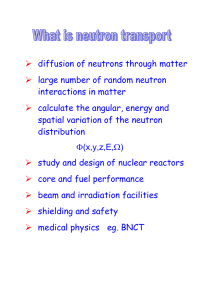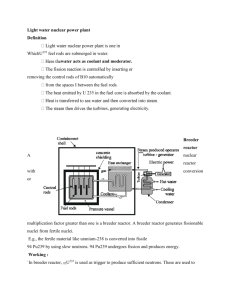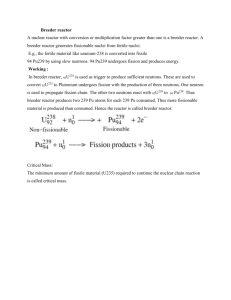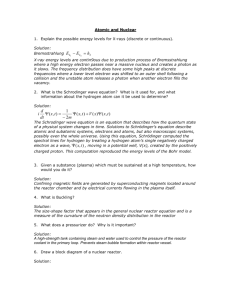22.54 Neutron Interactions and Applications (Spring 2004)
advertisement
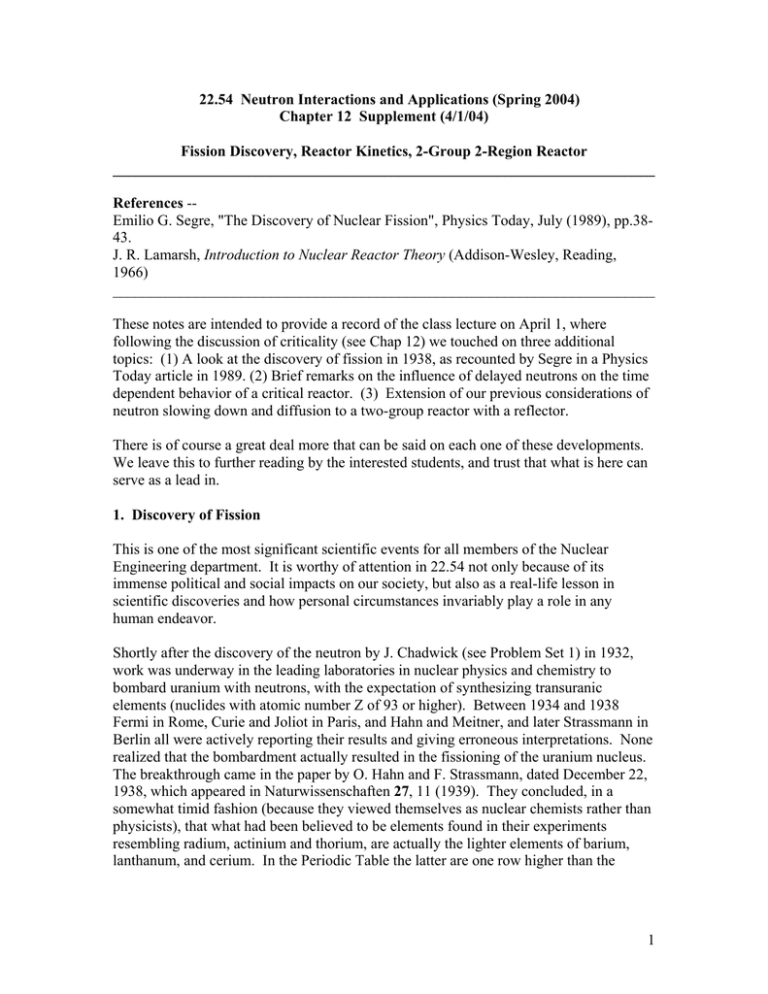
22.54 Neutron Interactions and Applications (Spring 2004)
Chapter 12 Supplement (4/1/04)
Fission Discovery, Reactor Kinetics, 2-Group 2-Region Reactor
________________________________________________________________________
References -Emilio G. Segre, "The Discovery of Nuclear Fission", Physics Today, July (1989), pp.3843.
J. R. Lamarsh, Introduction to Nuclear Reactor Theory (Addison-Wesley, Reading,
1966)
________________________________________________________________________
These notes are intended to provide a record of the class lecture on April 1, where
following the discussion of criticality (see Chap 12) we touched on three additional
topics: (1) A look at the discovery of fission in 1938, as recounted by Segre in a Physics
Today article in 1989. (2) Brief remarks on the influence of delayed neutrons on the time
dependent behavior of a critical reactor. (3) Extension of our previous considerations of
neutron slowing down and diffusion to a two-group reactor with a reflector.
There is of course a great deal more that can be said on each one of these developments.
We leave this to further reading by the interested students, and trust that what is here can
serve as a lead in.
1. Discovery of Fission
This is one of the most significant scientific events for all members of the Nuclear
Engineering department. It is worthy of attention in 22.54 not only because of its
immense political and social impacts on our society, but also as a real-life lesson in
scientific discoveries and how personal circumstances invariably play a role in any
human endeavor.
Shortly after the discovery of the neutron by J. Chadwick (see Problem Set 1) in 1932,
work was underway in the leading laboratories in nuclear physics and chemistry to
bombard uranium with neutrons, with the expectation of synthesizing transuranic
elements (nuclides with atomic number Z of 93 or higher). Between 1934 and 1938
Fermi in Rome, Curie and Joliot in Paris, and Hahn and Meitner, and later Strassmann in
Berlin all were actively reporting their results and giving erroneous interpretations. None
realized that the bombardment actually resulted in the fissioning of the uranium nucleus.
The breakthrough came in the paper by O. Hahn and F. Strassmann, dated December 22,
1938, which appeared in Naturwissenschaften 27, 11 (1939). They concluded, in a
somewhat timid fashion (because they viewed themselves as nuclear chemists rather than
physicists), that what had been believed to be elements found in their experiments
resembling radium, actinium and thorium, are actually the lighter elements of barium,
lanthanum, and cerium. In the Periodic Table the latter are one row higher than the
1
former. Thus there was no way for uranium plus neutron to give barium unless it
underwent fission.
For this work Hahn was awarded the Nobel Prize in Chemistry in 1944. One could ask
several questions. Why the epoch-making discovery was not recognized an achievement
in physics? Why there was no recognition of Strassmann? After all, he was a coauthor
of the paper, acknowledged to be the scientifically accepted formal announcement of the
discovery? Why there was no recognition of Meitner? She had been a close partner
working with Hahn up to July 1938 when she had to flee to Sweden because of possible
political persecution - she was an Austrian jew and Hitler annexed Austria in March. To
this date these questions and related ones are being discussed and debated.
The discovery immediately led to two apparently simple questions -- which fissioned,
U235 or U238, and how many neutrons are emitted? We all know that the answers have
profound implications regarding nuclear power and nuclear weapons. The military
significance of the discovery is a matter of history; the specter of nuclear warfare
continues to dominate human struggles across the globe. For a particularly fascinating
account of the World War II saga, we recommend Richard Rhodes, Making of Atomic
Bomb (1986).
We end this brief account by quoting Segre (who won the 1959 Nobel Prize in Physics
for his discovery of the antiproton) -"The discovery of fission has an uncommonly complicated history; many errors beset it.
Nature had, however, truly complicated the problem. One had to contend with the
radioactivity of natural uranium and the presence of two long-lived isotopes - U235 and
U238 . The heavier isotope, as is well (now) known, does not undergo fission when
bombarded by slow neutrons. The lighter isotope, which makes up only 0.7% of natural
uranium, is responsible for all slow-neutron fission. This a tricky set-up. Above all, it
seems to me that the human mind sees only what it expects."
2. Prompt vs. Delayed Criticality
As we have seen in Chap 12, the concept of criticality in a multiplying system such as a
nuclear reactor refers to a balance between the materials composition of the system (fuel
concentration, or fuel-to-moderator ratio, and various cross sections which determine the
reaction rates) and the system geometry and size. By solving the diffusion for a critical
reactor, this balance appears as an equality between the materials buckling Bm and the
geometric buckling Bg. When this condition is satisfied, there is a nontrivial solution to
the steady-state diffusion equation without a source, meaning that one can maintain a
steady-state flux in the absence of an external source, or in other words, the neutron
population ratio of the (n+1)th generation to the nth generation is unity.
Another way to describe critical behavior is through the time-variation of the flux as
given by an appropriate kinetics equation. Suppose we ignore spatial and energy
2
dependence and consider an infinite reactor in the absence of an external source. The
time dependence of the flux is then described by
1 dφ (t )
= (νΣ f − Σ a )φ (t )
v dt
(12S-1)
φ (t ) = φ (0)exp[(k∞ − 1)t / A p ]
(12S-2)
with solution,
In writing (12S-2) we have defined the infinite multiplication constant k∞ = νΣ f / Σ a , and
the prompt neutron lifetime A p = 1/ vΣ a . According to this simple result, if the reactor is
above (supercritical), k∞ > 1, the flux would rise exponentially in time with a period
T = A p /(k∞ − 1)
(12S-3)
For a rough estimate if take the lifetime A p to be typically 10-4 sec and ( k∞ − 1 ) to be 10-3,
T ~ 0.1 sec. This means that in a timespan of 1 sec the flux will increase by a factor e10 ~
2.2 x 104. Such a rate of change, if true, would be uncontrollable by any practical
means, since reactors are usually controlled by the mechanical insertion or withdrawal of
control rods made of materials which have high neutron absorption cross sections, for
example, cadmium.
Since reactors obviously do not actually behave in this manner because they can be
operated safely, what is wrong with our estimate? The answer lies in our neglect of
delayed neutrons. It is well known that not all the neutrons from fission come off
promptly. A certain fraction of the fission neutrons, β , are delayed in that these neutrons
are emitted from various decays of fission fragments, including β -decay which is a weak
interaction and therefore a slow process. U235, U238, and Pu239 each has six groups of
delayed neutrons, with the half life of a group varying from ~ 0.2 sec to ~ 54 sec (see
Table 3-8 on p. 102 of Lamarsh). The total delayed fraction β is 0.0064, 0.0148, and
0.002 respectively.
We can take into account the delayed neutrons in our estimate by revising our estimate of
the period T, using instead an average neutron lifetime which is significantly longer than
A p . At the same time we can refine our treatment of the multiplication effect by
replacing the infinite multiplication constant k∞ by the effective multiplication costant k.
Thus, our time-dependent reactor description becomes
A
d φ (t )
= [(1 − β )k − 1]φ (t ) + βφ (0)
dt
(12S-4)
where we denote the average neutron life time as A ,
3
6
A = (1 − β )A p + ∑ A i β i
(12S-5)
i =1
The important point to note is that the average life time is now of order 0.1 sec because of
the delayed neutrons, the second term in (12S-5). With this new value of the life time the
period T then becomes 10-1/10-3 ~ 100 sec. Now the flux increases by a factor of e in 100
sec which makes the reactor quite controllable by moving the control rods.
We can readily solve (12S-4) to obtain
φ (t ) = φ (0)exp{[(1 − β )k − 1]t / A} +
βφ (0)
(1 − exp{[(1 − β )k − 1]t / A})
1 − (1 − β )k
(12S-6)
For (1 − β )k < 1, the exponentials die out in time, the steady-state solution is
φ (t ) →
β
1 − (1 − β )k
φ (0)
(12S-7)
So at long times, the flux increase over the initial value is
φ (t ) / φ (0) →
β (1 − ρ )
β −ρ
(12S-8)
where we introduce the quantity called reactivity,
ρ≡
k − 1 ∆k
,
=
k
k
k=
1
1− ρ
(12S-9)
In reactor kinetics terminology, changing the multiplication constant by adding or
removing fuel, or inserting or withdrawing control rods, all can be carried out by a
specified reactivity ρ . Notice that (12S-8) gives an infinite jump when the amount of
reactivity introduced is equal to delayed neutron fraction. When this happens, the reactor
is said to be "prompt critical", which means that the reactivity is sufficient to make the
system critical without relying on the delayed neutrons. Then we are back to the original
of a very dangerous situation where the flux increases exponentially - a bomb scenario.
3. Two-Group Reflected Reactor
In elementary reactor physics a classic problem is the two-group two-region reactor
model. It is instructive to understand, even though only qualitatively, how one can
analyze the criticality of this system, because the insight provides the basis for many
practical calculations involving many energy groups and several reactor regions. The
latter are surely more complicated in detail, but the basic physics is no different.
4
We consider fast and thermal neutrons in a reactor with an inner core and an outer
reflector. We therefore distinguish cross sections, etc. and fluxes using a numerical
index:
1 -- fast neutrons in the core
2 -- thermal neutrons in the core
3 -- fast neutrons in the reflector
4 -- thermal neutrons in the reflector
and write the steady-state diffusion equations as
( D1∇ 2 − Σ a1 − Σ R1 − νΣ f 1 )φ1 + νΣ f 2φ2 = 0
Σ R1φ1 + ( D2∇ 2 − Σ a 2 )φ2 = 0
(12S-10)
( D3∇ 2 − Σ a 3 − Σ R 3 )φ3 = 0
( D4∇ 2 − Σ a 4 )φ4 + Σ R 3φ3 = 0
where Σ R denotes a "removal" cross section, in the sense of a neutron is transferred from
the fast group to the thermal group. One can give relatively simple expressions to
estimate this quantity, but we will not get into the details here because our focus is on the
overall structure of the problem.
Inspection of the system of four equations, (12S-10), shows that the system is coupled
through slowing down, diffusion, and fission. Fast neutrons in the core are produced by
thermal fission in the core while they are lost by slowing down in the core and by leakage
to the reflector. Fast neutrons in the reflector are produced by leakage from the core and
lost by slowing down to thermal. For the thermal neutrons in the core, they are produced
are produced by slowing down and lost by leakage to the reflector. In the reflector
thermal neutrons are produced by slowing down and by leakage. Given this model, the
mathematical problem now is to solve the coupled second-order differential equations
simultaneously with appropriate conditions at the core-reflector interface and at the outer
boundary of the reflector.
Although the symmetry between the fast and thermal flux in the core may not be
apparent, it turns out that φ1 and φ2 satisfy the same set of equations. This does not mean
they will be the same since each has its own boundary conditions. To bring out this
symmetry, we first rewrite (12S-10) in a more compact notation,
(∇ 2 + α11 )φ1 + α12φ2 = 0
α 21φ1 + (∇ 2 − α 22 )φ2 = 0
(12S-11)
5
(∇ 2 − α 33 )φ3 = 0
(∇ 2 − α 44 )φ4 + α 43φ3 = 0
with
α11 = (νΣ f 1 − Σ a1 − Σ R1 ) / D1
α 21 = Σ R1 / D2
α12 = νΣ f 2 / D1
α 22 = Σ a 2 / D2
α 33 = (Σ a 3 + Σ R 3 ) / D3
α 43 = Σ R 3 / D4
α 34 = 0
α 44 = Σ a 4 / D4
(12S-12)
Notice that in (12S-11) φ1 and φ2 are explicitly coupled to each other, whereas their
coupling to φ3 and φ4 appears only through the interface boundary conditions. Thus we
can use the first two equations to obtain an equation only in φ1 , and another equation only
in φ2 . The results are
(∇ 2 − α 22 )(∇ 2 + α11 )φ1 − α12α 21φ1 = 0
(12S-13)
(∇ 2 + α11 )(∇ 2 − α 22 )φ2 − α12α 21φ2 = 0
The one equation to be solved is of the form
(∇ 2 + µ 2 )(∇ 2 − ν 2 )φ = 0 ,
φ = φ1 , or φ2
(12S-14)
µ 2 − ν 2 = α11 − α 22
(12S-15)
µ 2ν 2 = α11α 22 + α12α 21
Next we consider a spherical core and write the general solutions in the form
φ (r ) = AZ (r ) + CW (r )
(12S-16)
1
(∇ 2 + µ 2 ) Z (r ) = 0 , Z (r ) ~ sin µ r
r
(12S-17)
1
(∇ 2 − ν 2 )W ( r ) = 0 , W (r ) ~ sinhν r
r
(12S-18)
φ1 (r ) A1
=
φ2 (r ) A2
(12S-19)
C1 Z (r )
C2 W ( r )
6
Notice that we accept only solutions that are finite everywhere in the system.
Similarly, for the reflector region we have
(∇ 2 − α 33 )U (r ) = 0 ,
1
U ( r ) ~ sinh α 33 ( R − r )
r
(12S-20)
(∇ 2 − α 44 )V (r ) = 0 ,
1
V (r ) ~ sinh α 44 ( R − r )
r
(12S-21)
φ3 ( r ) A3
=
φ4 (r ) A4
0 U ( r )
C4 V ( r )
(12S-22)
The integration constants A and C are constrained by the condition of no reentrant current
at reflector surface, for which we substitute extrapolated boundary conditions, and the
conditions at the core-reflector interface for which we specify continuity of flux and
current,
φ j ( R 2 ) = 0 ,
j=3,4
φ1 ( R ) = φ3 ( R) ,
φ2 ( R ) = φ4 ( R )
D1φ1 '( R ) = D3φ3 '( R) ,
D2φ2 '( R) = D4φ4 '( R)
(12S-23)
Applying these conditions one finds a set of 4 homogeneous equations for the 4 constants
A1, C1, A3, and C4. For nontrivial solutions, the determinant of the coefficients of these
four constants , comprised of the α 's, functions Z, W, U and V evaluated at R, and the
derivatives of these functions evaluated at R, must vanish. Let the determinant be
denoted as ∆ and regard this as a function of the core size R. One can numerically find
∆ (R) for several values of R, and then by interpolation find that value of R, say Rc,
which gives ∆ (Rc) = 0. This is the solution of the criticality problem, namely, the size of
critical core for given materials composition and concentration in the system.
This determination of the size of the critical reactor is the analogue of setting the material
buckling equal to the geometric buckling in the previous case of one speed neutron
diffusion equation (see Chap 11). Of course one can do the calculation for a given core
size and determine a material property such as the fuel to moderator ratio for the critical
system.
To conclude this discussion we show in Fig. 1 the the fast and thermal flux in a critical,
spherical reactor fueled with U235 with water as moderator and reflector. It is not
surprising that both fluxes have maximum at the center of the reactor, basically the same
7
2.0
Core
Neutron flux
1.5
Fast flux,
φ1
1.0
Slow flux,
φ2
0.5
0
0
5
10
15
-------------------
behavior as obtained when there is no reflector. What is somewhat unusual, at least at
first glance, is the peak in the thermal flux in the reflector. This is a new characteristic
feature associated with the two-group two-region system. Physically the peak signifies
that fast neutrons leaking out of the core and slowing down in the reflector can more than
compensate for the loss of thermal neutrons by leakage in the reflector. Mathematically,
the peak in φ4 arises from the sum of two terms, see (12S-22), a positive contribution
associated with U and a negative contribution associated with V. Regarding the latter as
the new effect, we might attribute the thermal flux peaking in the reflector to a significant
thermal absorption in the reflector, as measured by the constant α 44 in (12S-12).
20
Reflector
25
30
35
40
Distance from center of reactor, cm
Fig. 1. Profiles of the fast and thermal flux in a critical spherical reactor with a core that
is a homogeneous mixture of U235 and water, and a water reflector.
8


